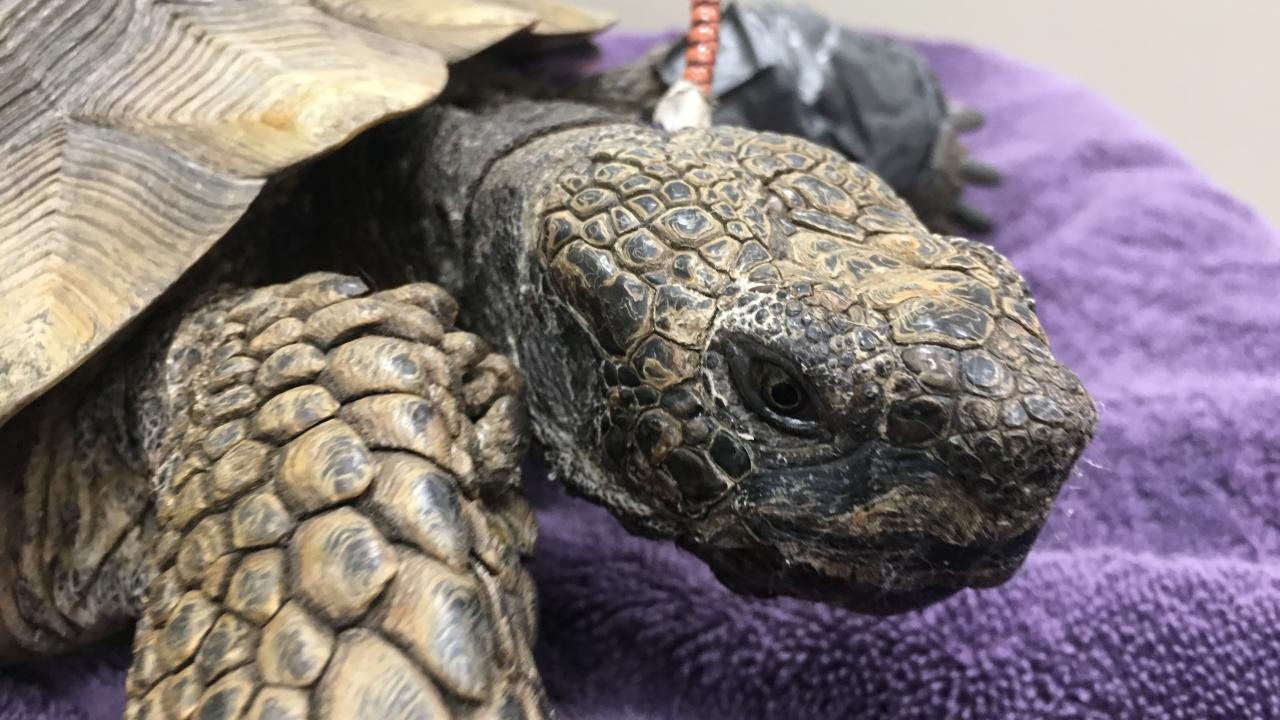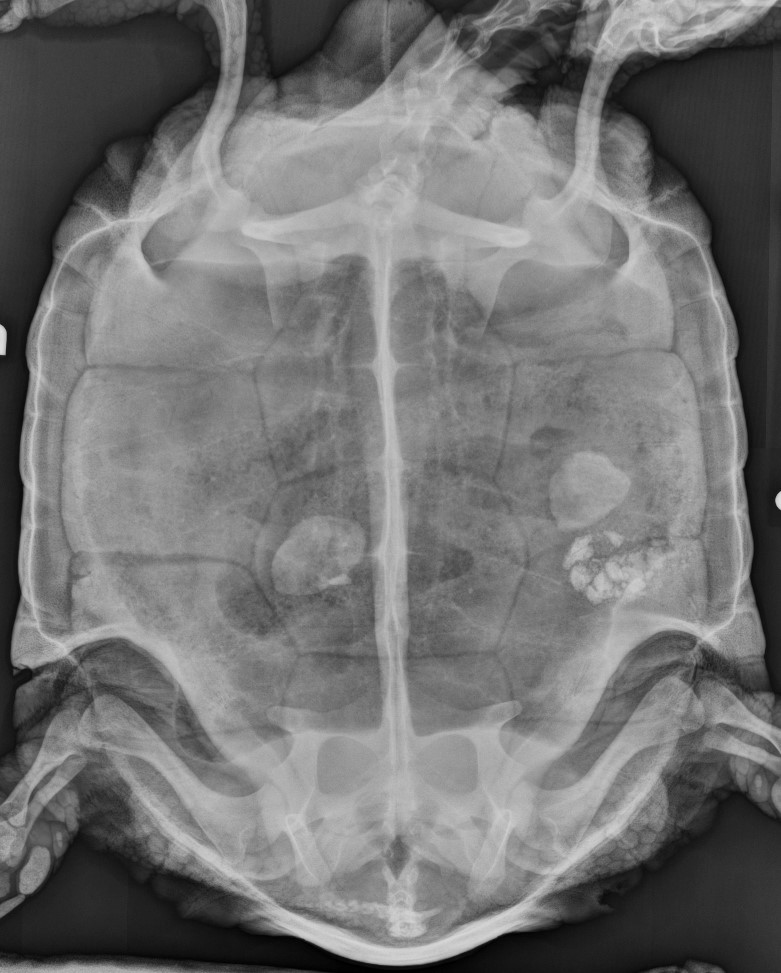
Exotics Team Treats 61-Year-Old Tortoise
Mohave, a 61-year-old desert tortoise, was recently brought to the UC Davis veterinary hospital for a recurrence of bladder stones – an issue he was previously treated for in 2014. A few weeks ago, his caretakers noticed that his urates (component of a reptile’s urine) were thick and pasty. Shortly thereafter, Mohave prolapsed his cloaca (common exit for the urinary and gastrointestinal tract); most likely due to straining to eliminate the pasty urates.
“We took some radiographs and saw some distinct white shapes within his coelomic (abdominal) cavity,” said Dr. Juliana Sorem, head veterinarian at Wildcare, a wildlife hospital and nature education center in San Rafael, and Mohave’s home since 2003. “We compared the images with the radiographs taken at his last routine physical and didn’t see these objects on them. Given his clinical signs and the radiographic images, I was fairly certain the stones had recurred.”
Dr. Sorem, a 2006 graduate of the UC Davis School of Veterinary Medicine, knew WildCare’s in-house clinic was not equipped for major surgical procedures, but she knew just where to take Mohave.

“Because UC Davis was able to successfully remove his previous bladder stones without having to cut his shell, we decided to pursue treatment there again,” said Dr. Sorem. “I particularly wanted to have the surgery done at UC Davis because of their extensive experience with exotics surgery and anesthesia.”
The hospital’s Companion Exotic Animal Medicine and Surgery Service is the largest center in California that treats exotic companion animals, and its clinicians have published research on Mohave’s condition.
Faculty member Dr. David Guzman and resident Dr. Sarah Ozawa were able to remove the stones via an endoscopic-assisted procedure. This minimally invasive technique allows the clinicians to access the bladder through the skin and muscles of the prefemoral fossa in front of the hind limb instead of having to cut through the plastron (shell). Due to Mohave’s regular care and annual check-ups, the stones were caught early enough to be removed in this fashion.
“After his previous bout with bladder stones, we started taking annual radiographs to look for new stones, in the hope that we might find them while they were still small,” Dr. Sorem said.
Dr. Guzman warns that if stones go unchecked for too long, they may grow so large that it could be complicated or impossible to be removed through a minimally invasive approach.
“If we have to enter through the plastron, it’s very invasive,” said Dr. Guzman. “It takes a long time to heal, and sometimes it fails to heal properly. So, Mohave’s case is a great example of the importance of annual check-ups for any animal.”
Wildcare’s wildlife hospital annually treats and (ideally) releases nearly 4,000 wild animals. Those that are deemed unfit to return to the wild become part of the center’s Wildlife Ambassador Program. Currently, there are 22 animal ambassadors that help children and adults understand and appreciate wildlife.
Mohave has been an ambassador for 16 years, after being found wandering the streets of Mendocino, a coastal town a few hours north of San Francisco – obviously, not a natural environment for a desert tortoise.
“Because he was found so far away from his natural environment, we believe he may have been taken from the desert and made someone’s pet,” said Alison Hermance, director of communications and marketing at Wildcare. “Desert tortoises are a threatened species, and as such, are not allowed to be returned to the wild; while in captivity they may have been exposed to pathogens or other things that may harm the existing wild population.”
Hermance states that Wildcare’s educational programs emphasize the importance of leaving wildlife in their natural environments.
“Fortunately, Mohave has taken well to his life at Wildcare,” said Hermance. “He makes for a great ambassador and educator. Everyone just loves to see him.”
At 61, Mohave still has plenty of living to do. In the wild, desert tortoises can live upwards of 80 years. In captivity, that life expectancy can be even longer.
Dr. Sorem states that Mohave is recovering well, although his appetite is not back to normal yet.
“Fortunately, his care team at UC Davis anticipated this and implanted a feeding tube while he was under anesthesia for his surgery,” said Dr. Sorem. “He has begun to show an interest in eating some of his favorite foods – dandelions, green beans, peas and strawberries, so we are hoping that the feeding tube can be removed soon.”
At a re-check appointment this week, Mohave continued to show signs of improvement, although his feeding tube will remain for the time being.
# # #
